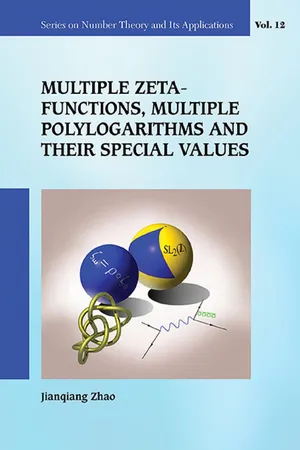
Multiple Zeta Functions, Multiple Polylogarithms And Their Special Values
- 620 pages
- English
- ePUB (mobile friendly)
- Available on iOS & Android
Multiple Zeta Functions, Multiple Polylogarithms And Their Special Values
About this book
This is the first introductory book on multiple zeta functions and multiple polylogarithms which are the generalizations of the Riemann zeta function and the classical polylogarithms, respectively, to the multiple variable setting. It contains all the basic concepts and the important properties of these functions and their special values. This book is aimed at graduate students, mathematicians and physicists who are interested in this current active area of research.
The book will provide a detailed and comprehensive introduction to these objects, their fascinating properties and interesting relations to other mathematical subjects, and various generalizations such as their q -analogs and their finite versions (by taking partial sums modulo suitable prime powers). Historical notes and exercises are provided at the end of each chapter.
Contents:
- Multiple Zeta Functions
- Multiple Polylogarithms (MPLs)
- Multiple Zeta Values (MZVs)
- Drinfeld Associator and Single-Valued MZVs
- Multiple Zeta Value Identities
- Symmetrized Multiple Zeta Values (SMZVs)
- Multiple Harmonic Sums (MHSs) and Alternating Version
- Finite Multiple Zeta Values and Finite Euler Sums
- q -Analogs of Multiple Harmonic (Star) Sums
Readership: Advanced undergraduates and graduate students in mathematics, mathematicians interested in multiple zeta values.
Zeta Functions;Polylogarithms;Multiple Zeta Functions;Multiple Zeta Values;Multiple Polylogarithms;Multiple Harmonic Sums;Double Shuffle Relations;Mixed Hodge Structures;Drinfeld Associator;Quasi-symmetric Functions;Regularizations;q-analogs Key Features:
- For the first time, a detailed explanation of the theory of multiple zeta values is given in book form along with numerous illustrations in explicit examples
- The book provides for the first time a comprehensive introduction to multiple polylogarithms and their special values at roots of unity, from the basic definitions to the more advanced topics in current active research
- The book contains a few quite intriguing results relating the special values of multiple zeta functions and multiple polylogarithms to other branches of mathematics and physics, such as knot theory and the theory of motives
- Many exercises contain supplementary materials which deepens the reader's understanding of the main text
Frequently asked questions
- Essential is ideal for learners and professionals who enjoy exploring a wide range of subjects. Access the Essential Library with 800,000+ trusted titles and best-sellers across business, personal growth, and the humanities. Includes unlimited reading time and Standard Read Aloud voice.
- Complete: Perfect for advanced learners and researchers needing full, unrestricted access. Unlock 1.4M+ books across hundreds of subjects, including academic and specialized titles. The Complete Plan also includes advanced features like Premium Read Aloud and Research Assistant.
Please note we cannot support devices running on iOS 13 and Android 7 or earlier. Learn more about using the app.
Information
Chapter 1
Multiple Zeta Functions
1.1Riemann Zeta Function










1.2Multiple Zeta Functions




1.3Analytic Continuation

Table of contents
- Cover
- Halftitle
- Series Editors
- Title
- Copyright
- Dedication
- Contents
- Preface
- Introduction
- 1. Multiple Zeta Functions
- 2. Multiple Polylogarithms (MPLs)
- 3. Multiple Zeta Values (MZVs)
- 4. Drinfeld Associator and Single-Valued MZVs
- 5. Multiple Zeta Value Identities
- 6. Symmetrized Multiple Zeta Values (SMZVs)
- 7. Multiple Harmonic Sums (MHSs) and Alternating Version
- 8. Finite Multiple Zeta Values and Finite Euler Sums
- 9. q-Analogs of Multiple Harmonic (Star) Sums
- 10. Multiple Zeta Star Values (MZ*Vs)
- 11. q-Analogs of Multiple Zeta Functions
- 12. q-Analogs of Multiple Zeta (Star) Values
- 13. Colored Multiple Zeta Values
- 14. Colored Multiple Zeta Values at Lower Levels
- 15. Application to Feynman Integrals
- Appendix A Key Concepts of Hopf Algebras
- Appendix B Some Useful Results from Lie Algebras
- Appendix C Basics of Hypergeometric Functions
- Appendix D Sample Computer Codes
- Appendix E Tables of Special Values
- Appendix F Answers to Some Exercises
- Bibliography
- List of Abbreviations
- List of Symbols
- Index